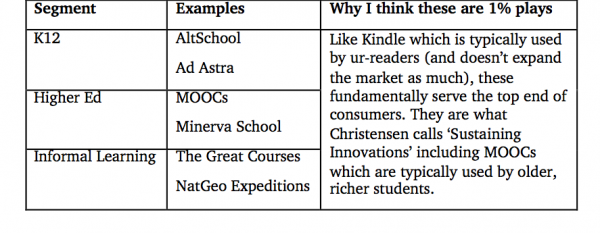I am presently in the Bay Area on a longish work assignment. Lots of interesting conversations, and many opportunities to gather insights abound. I do hope to share some of learnings and observations from my meetings in my next few posts.
During a recent dinner meeting with a leading Valley / Tech luminary, an interesting comment arose. This was during the end of the evening, while we were sampling some pricey single-source chocolate. Conversation then turned to $4 artisanal toast and other Valley food cliches. A guest described these as symbols of the 1% economy. The Bay Area has such a high concentration of wealth and numbers of the uber-rich that an entire segment of the economy is now devoted to serving the needs of this 1%, i.e., the Valley is now largely making products for itself.
This isnt an entirely original comment. Farhad Manjoo captured this wonderfully in a recent NYT article. And I am sure there are many other similiar articles as well.
Still, what struck me subsequently was that this 1% served as an appropriate filter to understand many of the innovations emerging from Silicon Valley, and how the Valley is approaching opportunities today. Many innovations and startups can be better understood through this 1% filter.
- Elon Musk doesn’t like the school his kids go to. So he creates Ad Astra.
- Rob Rhinehart creates Soylent as a food substitute that will save him “time, money, and effort the purchase, preparation, consumption, and clean-up of food was consuming” so that he can focus on coding
- Sergey Brin and Larry Page don’t want to die. So they are pumping millions via Google Ventures and Calico into funding cutting-edge biotech that can lead to increased longevity, for those who can afford it.
All these above examples of the 1% economy, in widely different fields, have a common theme. They are all top-down innovations. They start with an attempt to solve problems of ‘People Like Us’, and eventually trickle down to the masses.
Mobile phones are the definitive examples of top-down technology that has trickled down to the masses. This doesn’t mean that there is no bottom-up or low-end disruption in the mobile phone or telecom category. M-Pesa, Dual Sim are all examples, but they are few and far between. The bulk of product advances have been led by what the top-end of market could absorb, which then slowly become a product feature at the mass-end as well.
This 1% filter is a useful tool to understand Silicon Valley’s approach to education as well. Let us take three segments in education and look at the 1% plays in these segments.

There are of course innovations or offerings such as General Assemb.ly (and other similar code schools such as HackReactor, DevBootcamp), Enstitute which are examples of low-end or bottom-up innovation. These are all examples of unbundling an over-engineered product and exploring whether there are cheaper and more efficient ways of serving learners. This is a theme I have visited repeatedly in my blogs.
Other examples of bottom-up innovation would include Competency-based education (such as College for America) and the Global Freshman Academy initiative by Arizon State University.
It might be interesting at some point to compile and contrast a definitive list of top-down and bottom-up innovations.
